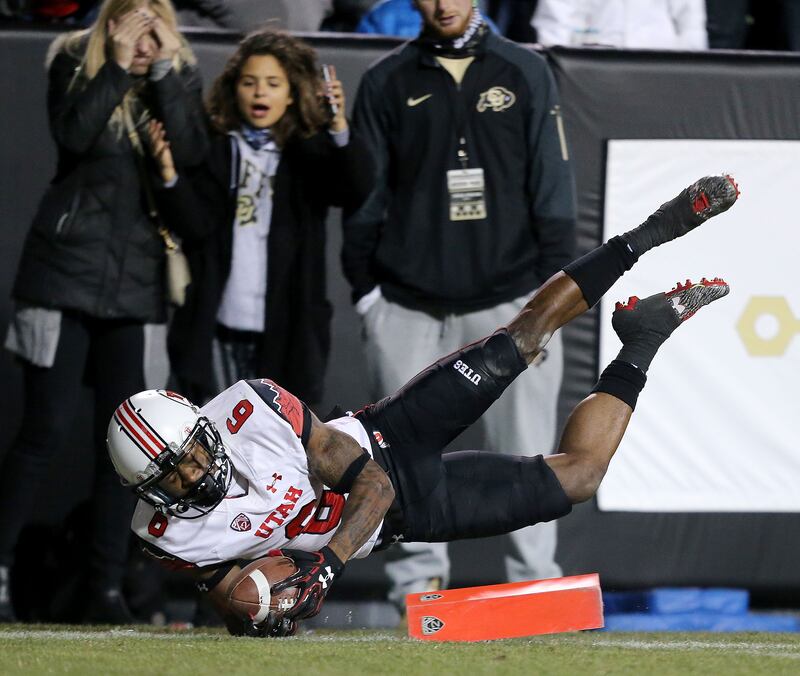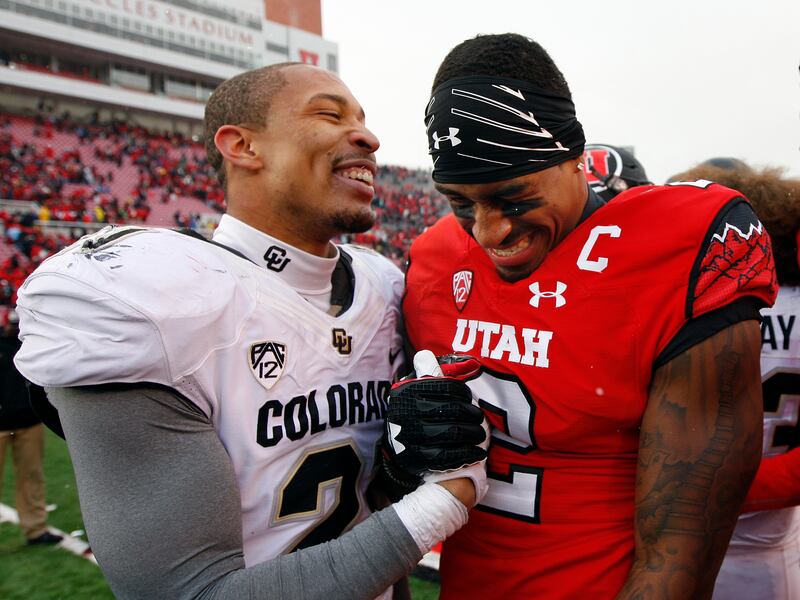SALT LAKE CITY — Can you smell it? The unique scent of turf, sweat and loathing that can only mean college football rivalry week? The one weekend when almost any team, no matter how good or bad, can salvage a forgettable campaign or punctuate a good one by beating the opponent they most love to hate.
If you’re a Utah or BYU fan, you probably can’t.
Across the country, the regular season’s grand finale showcases heated rivalries with colorful names and weird trophies. Ohio State plays Michigan at the Big House. Oregon meets Oregon State in the Civil War. Minnesota and Wisconsin vie for Paul Bunyan’s Axe.
Meanwhile, Utah plays ... Colorado? It’s a big game, with Utah still alive with national championship or Rose Bowl aspirations.
But Utes and Cougars agree: Theirs is the rivalry that matters for both schools. For years, they played on rivalry weekend, ending each season with the one game that could make it or break it. But since 2011, when Utah joined the Pac-12 and BYU became an independent, the game is no sure thing.
Instead, the Utes host the Buffaloes in the so-called “Rumble in the Rockies.” The rivalry might make sense in superficial ways — both schools are new to the Pac-12, play in its South Division and hail from cities that flank the Rocky Mountains — but lacks organic animosity or any sense of history. The teams didn’t play once between 1962 and 2011. The game quickly became known as one of college football’s manufactured rivalries.
At least BYU gets a trip to San Diego State. Fans are left out in the cold.
The absence of the end-of-year rivalry begs the question of what really defines a rivalry. Can organizers just slap a catchy name on a game or craft a trophy and make it so?
The makings of a fake rivalry
Last year, a scheduling quirk brought the Beehive State’s most heated contest back to rivalry week. Utah coach Kyle Whittingham championed the change, saying it had more of the “feel” and “buildup” that once defined the series. BYU’s Kalani Sitake added that playing the game at year’s end “just seems like that’s what should happen in rivalry games.”
Of course, it was only a brief reprieve, as the “team up north” and the “team down south” played early this season.
In the game’s stead, the Pac-12 has tried to promote the Rumble in the Rockies. A heated rivalry would benefit the conference, giving member schools another reason to stay and drawing more fans to lucrative stadiums and screens. But so far, the results have resembled rubbing flint and steel over the wet head of a mop.
Still, it’s not the most egregious example of an artificial rivalry. As conference realignment moved teams and shuffled schedules, traditional games like Pittsburgh-West Virginia and Oklahoma-Nebraska became rarities. They’re often replaced with intra-conference games that make more sense on paper and in meeting rooms than they do on the field. The paired opponents often don’t know much or care much about each other.
Utah played Colorado 57 times from 1903 to 1962, then forgot they existed for 49 years. There’s no trophy and no real bad blood between the schools.
Pac-12 administrators nevertheless felt it’d be a natural fit: The schools’ home states border each other, and they had a history. Plus, since they were both new to the conference, both were available to play each other.
Their plan hasn’t worked, per Whittingham.
“I would say just personally it’s too early still,” he told Deseret News columnist Brad Rock ahead of last year’s Colorado game. “I’ve said this several times over the last seven years: You can’t manufacture a rivalry. It’s got to happen.”

How does a real rivalry happen?
Rivalries arise from a kind of friction, whether due to frequent meetings with something big at stake — like a national title, as in the old Notre Dame-USC matchups in the Rose Bowl — or simple geography.
Florida and Florida State, for example, are about two and a half hours from each other. Their fans and alums share workplaces across the state. Many Gators and Seminoles played together in high school — or against each other. Their mutual disdain is palpable; players want to rub it in their former teammates’ faces, and fans want to “earn” bragging rights over co-workers.
Animosity helps. A good story doesn’t hurt.
Consider the tale behind Floyd of Rosedale — a 98-pound bronze pig contested by Minnesota and Iowa. Back in 1934, the Gophers stomped the Hawkeyes in Minneapolis, 48-12, and took a particular interest in Iowa tailback Ozzie Simmons, one of the conference’s few black players of the era. Minnesota players, he said, attacked him with late hits and pile-ons, sending him off early with bruised ribs.
The next year, Iowa Governor Clyde Herring issued a warning to the visitors from Minnesota: Even if the referees allowed more brutalization of Simmons, the crowd wouldn’t. Trying to relieve the tension, Minnesota Gov. Floyd Olsen offered Herring a friendly wager on the game’s outcome: An Iowa prize hog against a Minnesota prize hog. Minnesota won, taking home a live Hampshire from Rosedale Farms. It was named Floyd, after the governor, who commissioned a sculpture in Floyd’s image. Thus, the Floyd of Rosedale trophy was born, a bronze pig forged from a heated feud stoked by the very real tensions of racial integration.
That was a perfect recipe for of a rivalry: Geographic proximity, true disdain, history and a cool-looking, organic trophy that meant something to everybody involved.
The most notorious fake rivalry of them all
On the other hand, consider the game former UConn coach Bob Diaco dubbed the “Civil ConFLiCT” — capitalizing FL and CT for Florida and Connecticut.
In 2014, after UConn upset Central Florida in the second battle between new members of the American Athletic Conference, Diaco talked up a north-south rivalry between the schools. It wasn’t taken too seriously.
That didn’t stop UConn from trying. At the beginning of the 2015 season, the team posted a photo of a countdown clock on Twitter showing the days, hours, minutes and seconds until the Huskies’ next matchup against the Knights, with “Beat UCF” beneath it. Below that was the image of a generic-looking trophy — nothing like the Milk Can or Jeweled Shillelagh or Iron Skillet or Old Brass Spittoon — engraved with “CIVIL CONFLICT,” a husky, a knight and space to record future victories.
When UCF beat UConn that year, the Knights showed how they felt about the rivalry by leaving the trophy on the field. That was about the end of it. The trophy’s whereabouts remain unknown.
In a press conference, Diaco explained he just wanted “to add some intrigue, to add some interest, to add some fair, wonderful, intercollegiate, awesome energy” to an otherwise forgettable game for two programs with little in common. He also wondered aloud how many articles the reporters in attendance had written about the Civil ConFLiCT and called its demise “disappointing.”
With UConn going independent next season, 2019 marked the last of that “rivalry.” SB Nation’s Underdog Dynasty mourned the occasion as “The end of an error,” and the Tampa Bay Times labeled it “the dumbest rivalry in college sports history.”
The obvious animosity of true rivals
A true rivalry could never go unnoticed. Texas and Texas A&M haven’t played since A&M left the Big 12 for the Southeastern Conference in 2011. Before that, the Longhorns and Aggies were a Thanksgiving weekend staple — one that’s still missed.
As evidence, take a look at the manure bucket for Bevo, Texas’ live longhorn mascot. It’s still Texas A&M maroon, with the A&M logo and “13th man” written on the side. That’s rivalry. Nearly a decade since the schools ceased play, they’re still taking shots at each other.
Perhaps that’s the best way to define a rivalry: A game that’s anticipated and would be missed. Because it means something to both teams. And what it means is bigger than a title or a victory or an invitation to a bowl. What it means is they flat-out hate each other.
That’s not something you can create in a PowerPoint presentation.
By this standard, it’s difficult to even call Saturday’s Rumble in the Rockies a rivalry, even if Colorado puts up their best game. A loss would disappoint the Utes, but it wouldn’t end their season in infamy.
Not like it would if they lost to BYU. The BYU-Utah game remains a rivalry in its purest form. Even when the teams don’t play, their respective wins and losses inspire both heartache and rage. It’s a matchup backed by history and memories, guaranteeing there’s at least one Saturday each year — or most years, these days — when neither team’s fans have to wonder what the schools are playing for.


